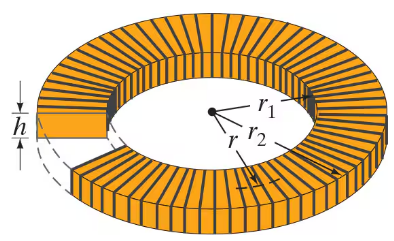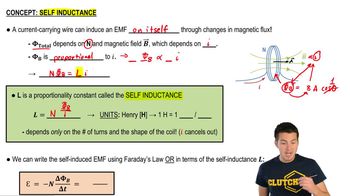Determine the inductance L of a 0.60-m-long air-filled solenoid 2.9 cm in diameter containing 7500 loops.
Table of contents
- 0. Math Review31m
- 1. Intro to Physics Units1h 29m
- 2. 1D Motion / Kinematics3h 56m
- Vectors, Scalars, & Displacement13m
- Average Velocity32m
- Intro to Acceleration7m
- Position-Time Graphs & Velocity26m
- Conceptual Problems with Position-Time Graphs22m
- Velocity-Time Graphs & Acceleration5m
- Calculating Displacement from Velocity-Time Graphs15m
- Conceptual Problems with Velocity-Time Graphs10m
- Calculating Change in Velocity from Acceleration-Time Graphs10m
- Graphing Position, Velocity, and Acceleration Graphs11m
- Kinematics Equations37m
- Vertical Motion and Free Fall19m
- Catch/Overtake Problems23m
- 3. Vectors2h 43m
- Review of Vectors vs. Scalars1m
- Introduction to Vectors7m
- Adding Vectors Graphically22m
- Vector Composition & Decomposition11m
- Adding Vectors by Components13m
- Trig Review24m
- Unit Vectors15m
- Introduction to Dot Product (Scalar Product)12m
- Calculating Dot Product Using Components12m
- Intro to Cross Product (Vector Product)23m
- Calculating Cross Product Using Components17m
- 4. 2D Kinematics1h 42m
- 5. Projectile Motion3h 6m
- 6. Intro to Forces (Dynamics)3h 22m
- 7. Friction, Inclines, Systems2h 44m
- 8. Centripetal Forces & Gravitation7h 26m
- Uniform Circular Motion7m
- Period and Frequency in Uniform Circular Motion20m
- Centripetal Forces15m
- Vertical Centripetal Forces10m
- Flat Curves9m
- Banked Curves10m
- Newton's Law of Gravity30m
- Gravitational Forces in 2D25m
- Acceleration Due to Gravity13m
- Satellite Motion: Intro5m
- Satellite Motion: Speed & Period35m
- Geosynchronous Orbits15m
- Overview of Kepler's Laws5m
- Kepler's First Law11m
- Kepler's Third Law16m
- Kepler's Third Law for Elliptical Orbits15m
- Gravitational Potential Energy21m
- Gravitational Potential Energy for Systems of Masses17m
- Escape Velocity21m
- Energy of Circular Orbits23m
- Energy of Elliptical Orbits36m
- Black Holes16m
- Gravitational Force Inside the Earth13m
- Mass Distribution with Calculus45m
- 9. Work & Energy1h 59m
- 10. Conservation of Energy2h 54m
- Intro to Energy Types3m
- Gravitational Potential Energy10m
- Intro to Conservation of Energy32m
- Energy with Non-Conservative Forces20m
- Springs & Elastic Potential Energy19m
- Solving Projectile Motion Using Energy13m
- Motion Along Curved Paths4m
- Rollercoaster Problems13m
- Pendulum Problems13m
- Energy in Connected Objects (Systems)24m
- Force & Potential Energy18m
- 11. Momentum & Impulse3h 40m
- Intro to Momentum11m
- Intro to Impulse14m
- Impulse with Variable Forces12m
- Intro to Conservation of Momentum17m
- Push-Away Problems19m
- Types of Collisions4m
- Completely Inelastic Collisions28m
- Adding Mass to a Moving System8m
- Collisions & Motion (Momentum & Energy)26m
- Ballistic Pendulum14m
- Collisions with Springs13m
- Elastic Collisions24m
- How to Identify the Type of Collision9m
- Intro to Center of Mass15m
- 12. Rotational Kinematics2h 59m
- 13. Rotational Inertia & Energy7h 4m
- More Conservation of Energy Problems54m
- Conservation of Energy in Rolling Motion45m
- Parallel Axis Theorem13m
- Intro to Moment of Inertia28m
- Moment of Inertia via Integration18m
- Moment of Inertia of Systems23m
- Moment of Inertia & Mass Distribution10m
- Intro to Rotational Kinetic Energy16m
- Energy of Rolling Motion18m
- Types of Motion & Energy24m
- Conservation of Energy with Rotation35m
- Torque with Kinematic Equations56m
- Rotational Dynamics with Two Motions50m
- Rotational Dynamics of Rolling Motion27m
- 14. Torque & Rotational Dynamics2h 5m
- 15. Rotational Equilibrium3h 39m
- 16. Angular Momentum3h 6m
- Opening/Closing Arms on Rotating Stool18m
- Conservation of Angular Momentum46m
- Angular Momentum & Newton's Second Law10m
- Intro to Angular Collisions15m
- Jumping Into/Out of Moving Disc23m
- Spinning on String of Variable Length20m
- Angular Collisions with Linear Motion8m
- Intro to Angular Momentum15m
- Angular Momentum of a Point Mass21m
- Angular Momentum of Objects in Linear Motion7m
- 17. Periodic Motion2h 9m
- 18. Waves & Sound3h 40m
- Intro to Waves11m
- Velocity of Transverse Waves21m
- Velocity of Longitudinal Waves11m
- Wave Functions31m
- Phase Constant14m
- Average Power of Waves on Strings10m
- Wave Intensity19m
- Sound Intensity13m
- Wave Interference8m
- Superposition of Wave Functions3m
- Standing Waves30m
- Standing Wave Functions14m
- Standing Sound Waves12m
- Beats8m
- The Doppler Effect7m
- 19. Fluid Mechanics4h 27m
- 20. Heat and Temperature3h 7m
- Temperature16m
- Linear Thermal Expansion14m
- Volume Thermal Expansion14m
- Moles and Avogadro's Number14m
- Specific Heat & Temperature Changes12m
- Latent Heat & Phase Changes16m
- Intro to Calorimetry21m
- Calorimetry with Temperature and Phase Changes15m
- Advanced Calorimetry: Equilibrium Temperature with Phase Changes9m
- Phase Diagrams, Triple Points and Critical Points6m
- Heat Transfer44m
- 21. Kinetic Theory of Ideal Gases1h 50m
- 22. The First Law of Thermodynamics1h 26m
- 23. The Second Law of Thermodynamics3h 11m
- 24. Electric Force & Field; Gauss' Law3h 42m
- 25. Electric Potential1h 51m
- 26. Capacitors & Dielectrics2h 2m
- 27. Resistors & DC Circuits3h 8m
- 28. Magnetic Fields and Forces2h 23m
- 29. Sources of Magnetic Field2h 30m
- Magnetic Field Produced by Moving Charges10m
- Magnetic Field Produced by Straight Currents27m
- Magnetic Force Between Parallel Currents12m
- Magnetic Force Between Two Moving Charges9m
- Magnetic Field Produced by Loops andSolenoids42m
- Toroidal Solenoids aka Toroids12m
- Biot-Savart Law (Calculus)18m
- Ampere's Law (Calculus)17m
- 30. Induction and Inductance3h 38m
- 31. Alternating Current2h 37m
- Alternating Voltages and Currents18m
- RMS Current and Voltage9m
- Phasors20m
- Resistors in AC Circuits9m
- Phasors for Resistors7m
- Capacitors in AC Circuits16m
- Phasors for Capacitors8m
- Inductors in AC Circuits13m
- Phasors for Inductors7m
- Impedance in AC Circuits18m
- Series LRC Circuits11m
- Resonance in Series LRC Circuits10m
- Power in AC Circuits5m
- 32. Electromagnetic Waves2h 14m
- 33. Geometric Optics2h 57m
- 34. Wave Optics1h 15m
- 35. Special Relativity2h 10m
30. Induction and Inductance
Self Inductance
Problem 13
Textbook Question
(III) A toroid has a rectangular cross section as shown in Fig. 30–26. Show that the self-inductance is
where N is the total number of turns and r₁, r₂ and h are the dimensions shown in Fig. 30–26. [Hint: Use Ampère’s law to get B as a function of r inside the toroid, and integrate.]

 Verified step by step guidance
Verified step by step guidance1
Step 1: Begin by understanding the geometry of the toroid. A toroid is a circular coil with a rectangular cross-section. The dimensions provided are r₁ (inner radius), r₂ (outer radius), and h (height of the rectangular cross-section). The total number of turns is N.
Step 2: Use Ampère’s law to find the magnetic field B inside the toroid. Ampère’s law states: ∮B·dl = μ₀I_enclosed, where I_enclosed is the current enclosed by the path. For a toroid, the path of integration is a circular loop of radius r within the toroid. The enclosed current is N times the current I in each turn, so I_enclosed = N·I. The magnetic field B is uniform along the circular path, and the path length is 2πr. Thus, B·(2πr) = μ₀(N·I), leading to B = (μ₀N·I) / (2πr).
Step 3: The self-inductance L is defined as the ratio of the magnetic flux Φ to the current I: L = Φ / I. To calculate Φ, consider the magnetic flux through the cross-sectional area of the toroid. The flux through a small strip of width dr at radius r is dΦ = B·(h·dr), where h is the height of the rectangular cross-section. Substitute B = (μ₀N·I) / (2πr) into this expression: dΦ = [(μ₀N·I) / (2πr)]·(h·dr).
Step 4: Integrate dΦ over the range of r from r₁ to r₂ to find the total magnetic flux Φ. The integral is Φ = ∫[r₁ to r₂] [(μ₀N·I) / (2πr)]·(h·dr). Factor out constants μ₀, N, I, h, and 2π from the integral: Φ = (μ₀N·I·h) / (2π) ∫[r₁ to r₂] (1/r) dr. The integral of 1/r is ln(r), so Φ = (μ₀N·I·h) / (2π)·[ln(r₂) - ln(r₁)].
Step 5: Divide Φ by I to find the self-inductance L. Since L = Φ / I, substitute Φ: L = [(μ₀N·h) / (2π)]·[ln(r₂) - ln(r₁)]. Combine the logarithmic terms using the property ln(a) - ln(b) = ln(a/b): L = [(μ₀N²·h) / (2π)]·ln(r₂ / r₁). This is the expression for the self-inductance of the toroid.
 Verified video answer for a similar problem:
Verified video answer for a similar problem:This video solution was recommended by our tutors as helpful for the problem above
Video duration:
6mPlay a video:
Was this helpful?
Key Concepts
Here are the essential concepts you must grasp in order to answer the question correctly.
Self-Inductance
Self-inductance is a property of a coil or circuit that quantifies its ability to induce an electromotive force (EMF) in itself due to a change in current. It is represented by the symbol L and is measured in henries (H). The self-inductance depends on the geometry of the coil, the number of turns, and the magnetic permeability of the core material.
Recommended video:
Guided course

Self Inductance
Ampère’s Law
Ampère’s Law relates the integrated magnetic field around a closed loop to the electric current passing through the loop. Mathematically, it states that the line integral of the magnetic field B around a closed path is equal to μ₀ times the total current I enclosed by the path. This law is fundamental in deriving the magnetic field inside a toroid, which is essential for calculating self-inductance.
Recommended video:
Guided course

Gauss' Law
Magnetic Field in a Toroid
The magnetic field inside a toroid is generated by the current flowing through its windings and is confined within the core. The magnetic field strength B at a distance r from the center of the toroid can be derived using Ampère’s Law, leading to the expression B = (μ₀N I) / (2πr) for r between the inner and outer radii. Understanding this relationship is crucial for calculating the self-inductance of the toroid.
Recommended video:
Guided course

Toroidal Solenoids aka Toroids
Related Videos
Related Practice
Textbook Question
649
views


